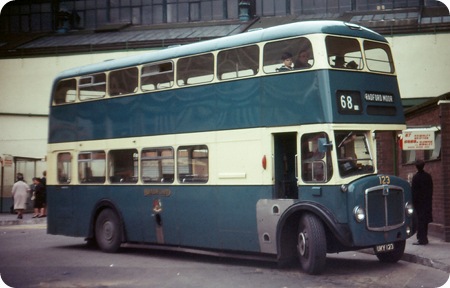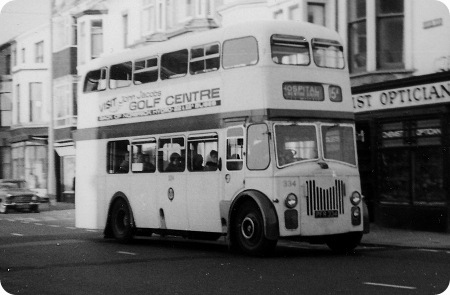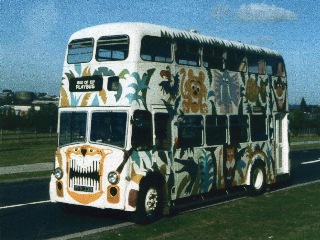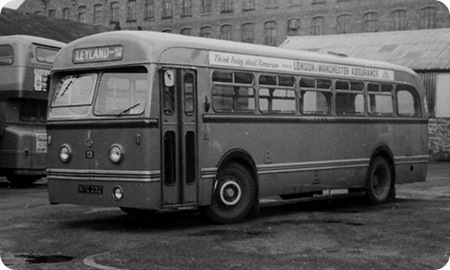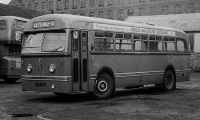Bradford Corporation – AEC Regent V – UKY 123 – 123
Bradford Corporation Transport
1961
AEC Regent V
MCW H39/31F
After my lengthy piece re the Routemaster yesterday I will keep the information on today’s bus to the point. It is a straight forward AEC Regent V with an AEC 9.6 litre engine, monocontrol four speed direct selection gearbox and air brakes, nothing controversial there unless you can come up with something, leave a comment if you do.
A full list of Regent V codes can be seen here.
Bus tickets issued by this operator can be viewed here.
———
I lived in Eldwick in the 60s. The village was originally served by the West Yorkshire services 62/62A from the forecourt of Bingley railway station. At some time these routs were extended through to Bradford and became jointly operated with the municipality. West Yorkshire ran its trusty FS Lodekkas and Bradford Corporation its Regents. The Service runs up the side of the Aire Valley escarpment to Eldwick on gradients of varying severity. The Lodekkas had vastly superior hill climbing qualities to the Regents. When Bradford dual sourced Daimlers and PD3s the Neepsend bodied Daimler CVG6LXs were a far better proposition for this service in respect to the hill climbing potential afforded by the Gardener engine.
Charles in Australia
———
Charles, greetings!
I lived in Eldwick from 1957 until 1983 and have fond memories of the 62/62A service, which for many years terminated in the car park at the Acorn Inn. In time this had to move to Spring Lane where buses had to undertake a very tricky reversing manoeuvre.
When West Yorkshire made application to extend the service to Bradford the Bradford Corporation sought licence for a rival service to the village. Eventually joint operation was agreed and I remember vividly the Bradford City Transport AEC Regents appearing in the village on driver route familiarisation duties. They made very heavy weather of the climb from Beck Bottom towards Dick Hudson’s.
When the joint service began on 6 March 1966 the Bradford City Transport used Regents (which were housed at Saltaire Depot). The period of Regent operation was quite brief as in the autumn of 1966 the Corporation received a batch of 15 Daimler CVG6/30 with East Lancashire (Neepsend) bodywork. As you say, they were a far better proposition for the Eldwick route. The first seven of the batch 226-233 (EAK 226-233D) were allocated to Saltaire Depot, the rest 234-240 (EAK 234-240D) going to Ludlam Street and later finishing their BCT-days at Horton Bank Top Depot where they were used on the 9/10/12 Buttershaw-Stanningly and 76/77 Bradford-Halifax services.
I was the last Junior Traffic Clerk to be employed by Bradford City Transport joining the undertaking on 1 October 1973. As I recall the Corporation’s Monday to Friday vehicle allocation to the Eldwick route was 2 buses (0625 out of Saltaire Depot and 0645). Saturday may have been different but Sunday was 1 bus (1005 out of Saltaire Depot).
The other interesting aspect about the Eldwick route that I recall is that prior to joint operation with Bradford City Transport the West Yorkshire allocation would often be a Keighley-West Yorkshire Lodekka.
In fact I recollect that in the autumn of 1966 not only did we have the new BCT CVGs but new Keighley-West Yorkshire Lodekkas (KDX 224-227).
Kevin Hey
———
15/08/11 – 13:32
This is No 123 one of the second batch of Monocontrol Mk V’s 121-125 which had the noisier dry liner AV590 engine rather than the previous A208 unit as used on the Mk III. They were reputed to be very thirsty and were outlasted by the previous 1959 batch of Monocontrol Mk V’s 106-120. With the arrival of new manager Wake from St Helens huge batches of St Helens spec synchromesh Mk V were ordered 126-225 to replace the trolleybuses. Bradford hills and ex trolleybus drivers made a lethal clutch destroying team and things got so bad two (224 225) were expensively fitted with Monocontrol and AV691 engines but with AEC fitting the heavy Mammoth Major clutch, things settled down and no more were done. Truly horrid things.
Kev
———
15/08/11 – 21:54
Well Kev, you have answered a question which has puzzled me for years, namely as to why the UKY batch were withdrawn before the PKY. Now I know!
I always thought the PKY series were much better quality vehicles than the later batches. They certainly gave that impression, and I was a regular Regent V customer. I well remember 224 and 225 being fitted with Monocontrol, and thought they were thereby improved, but, as a BCT enthusiast, the mark V Regents are, to me, probably best forgotten!
John Whitaker
———
15/08/11 – 22:02
Kev, the reliable AEC 9.6 litre engines up to A218 were all dry liner engines, and these were replaced from around 1958 by the wet liner AV590. All the Southall wet liner engines were a constant source of trouble, and AEC finally gave up the struggle with them and went back to dry liners with the AH505 and AV or AH691. When driving them, I always felt that AEC engines were inferior in the low speed torque area to Gardner and Leyland engines, yet the London RT was always a more lively performer on hills than the RTL. When some red RTLs were painted green and sent to the Country Area, they were quickly deemed to be unsatisfactory, and were sent back again to be replaced by RTs.
Roger Cox
———
16/08/11 – 09:00
I’m on record as acknowledging the weakness of the wet liner AH/AV590. However, I’m not aware of major problems with Sheffield’s series 2 Regent Vs. Bradford’s territory is no more punishing than Sheffield’s and I cannot comment whether they were nasty or not. Sheffield’s weren’t. Did Bradford lack the will to work with them (as LT did with more modern buses)? What were Bradford’s maintenance standards like? [I don’t know.]
Roger is correct about the characteristics of the three major engines. Noel Millier (respected PSV journalist of the ’60s and ’70s) calls the AECs the thoroughbreds, the Leylands and Gardners the reliable plodders. That is being realistically and honestly complementary to all three. OK, I am AEC man, but the PD2/3 is also one of my favourite buses. My experience with (albeit preserved) RTLs is that they move like slugs compared with RTs. Interestingly enough, experience driving RMs in service in Reading is quite the contrary. Reading Mainline’s Leyland powered RMs romped up Norcot Hill – so individual circumstances change constantly.
David Oldfield
———
17/08/11 – 07:21
Bradford were as good as anyone else at bus maintenance. The Mk Vs were purchased, I believe, as the cheapest option for mass trolleybus replacement. anyone connected with the City`s transport will tell you what horrors they were!
I too like AEC`s, David, but not from that generation!
They were noisy, juddering, rough riding and slow, and were hated by everyone in the City!
John Whitaker
———
17/08/11 – 07:24
David, it is a curious thing that London Transport always seemed to be the exception in proving any rule. The Fleetline debacle was probably the most extreme example, and much of the blame lay with the LT engineering system. Aldenham was designed to overhaul buses that could be dismantled like Meccano, and the RT/RTL/RTW, RF and RM classes were specifically designed to be taken to pieces and reconstructed accordingly. Other types like the Fleetline and Swift/Merlin, didn’t fit this bill. Yet LT, unlike many provincial operators, seemed to have very little trouble with the wet liner AV590 in the RM, though the story with the wet liner Reliance in LTE service was very different. The RW, RC and RP classes and their utilisation graphically demonstrated London Transport’s ability to waste public money.
Roger Cox
———
17/08/11 – 10:29
There is a clue in what John says. I recall, I think, that Bradford’s trolleybus withdrawal was not scheduled: do I remember that there was an accident- possibly a fatality- involving falling trolley booms and the Corporation took fright & withdrew the trolleys as quickly as possible? They may have then found that the plant- poles & wires- were in poor condition. This may have led to bargains being sought from manufacturers whose buses were going out of fashion? It would be typically Bradford not to embrace the "new" bustle buses, but look to tradition! Have I got my history right or are memories muddled?
Joe
———
17/08/11 – 13:22
Yes Joe, there was a trolley head fatality at Four Lane Ends which may have affected the abandonment schedule, but I think the main reason was the over hasty city centre redevelopment, most of which has itself now been demolished. BCT certainly utilised much second hand trolleybus equipment in the fifties and sixties, enabling it to last as long as it did, but events overtook them a bit, and they were faced with inflated motorbus demands.
AEC were probably the cheapest option, and the Mark Vs were very unpopular among the public, even amongst the "a bus is a bus" brigade. Letters were written to the Telegraph and Argus about Bradford’s latest monstrosities!
I am only an enthusiast, so cannot comment technically, and the Mark Vs did have some attraction to the enthusiast, even if it were just the unpopular aura which surrounded them! Were they really built by the same organisation who built the 1-40 batch some 12 years earlier?
John Whitaker
———
23/08/11 – 10:07
The Mark Vs in Bradford service had two major problems as far as I am aware. These were broken injector pipes, there being a fitter stationed at Forster Square to deal with these on a full time basis, and blown cylinder head gaskets probably caused by bad driving on steep hills where labouring the engine would cause this sort of problem. The injector pipe problem was of BCTs own making as the anti vibration clips were often not refitted at replacement. The problem was eventually cured by redesigning replacement pipes to something akin to a Gardner injector pipe so I was told by a gentleman who did this and later set up a business supplying pipes to Volvo for use on their engines. I have it on good authority from former chief engineer Bernard Browne that the difficulties in obtaining spares and the problems of day to day operation led to the later purchases of CVG6 and PD3A to enable replacement of early examples and provide more reliable motorbuses for the fleet
David Hudson
Quick links to the - Comments Page - Contact Page - Home Page
